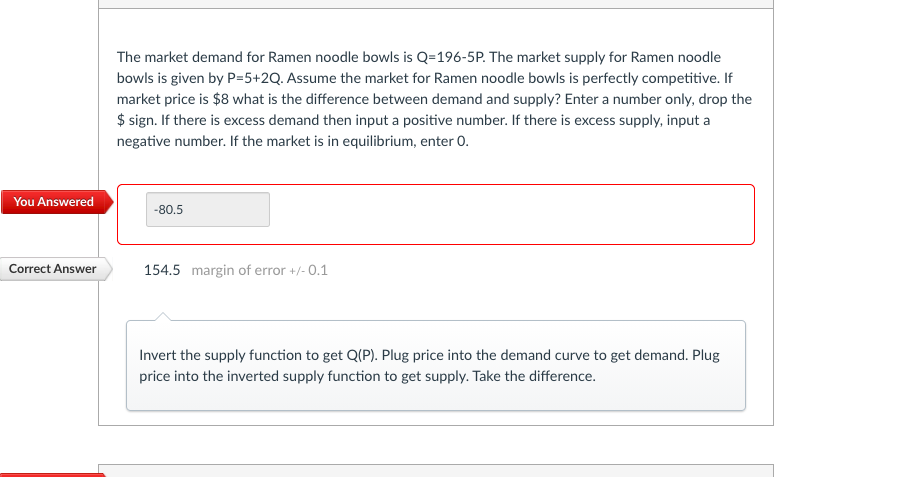The market demand for Ramen noodle bowls is Q=196-5P. The market supply for Ramen noodle bowls is given by P=5+2Q. Assume the market for Ramen noodle bowls is perfectly competitive. If market price is $8 what is the difference between demand and supply? Enter a number only, drop the $ sign. If there is excess demand then input a positive number. If there is excess supply, input a negative number. If the market is in equilibrium, enter 0.
The market demand for Ramen noodle bowls is Q=196-5P. The market supply for Ramen noodle bowls is given by P=5+2Q. Assume the market for Ramen noodle bowls is perfectly competitive. If market price is $8 what is the difference between demand and supply? Enter a number only, drop the $ sign. If there is excess demand then input a positive number. If there is excess supply, input a negative number. If the market is in equilibrium, enter 0.
Chapter3: Market Demand And Supply
Section: Chapter Questions
Problem 6SQ
Related questions
Question
Question in image. Been stuck on for hours.
If you don't understand how to solve, let someone else answer it instead of rejecting question
Warm regards.

Transcribed Image Text:The market demand for Ramen noodle bowls is Q=196-5P. The market supply for Ramen noodle
bowls is given by P=5+2Q. Assume the market for Ramen noodle bowls is perfectly competitive. If
market price is $8 what is the difference between demand and supply? Enter a number only, drop the
$ sign. If there is excess demand then input a positive number. If there is excess supply, input a
negative number. If the market is in equilibrium, enter 0.
You Answered
-80.5
Correct Answer
154.5 margin of error +/- 0.1
Invert the supply function to get Q(P). Plug price into the demand curve to get demand. Plug
price into the inverted supply function to get supply. Take the difference.
Expert Solution
This question has been solved!
Explore an expertly crafted, step-by-step solution for a thorough understanding of key concepts.
Step by step
Solved in 2 steps with 2 images

Knowledge Booster
Learn more about
Need a deep-dive on the concept behind this application? Look no further. Learn more about this topic, economics and related others by exploring similar questions and additional content below.Recommended textbooks for you








